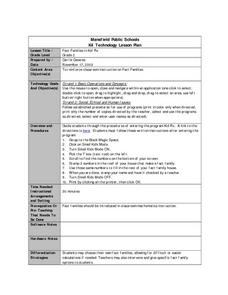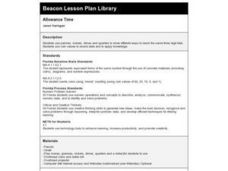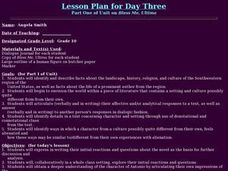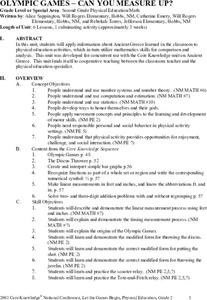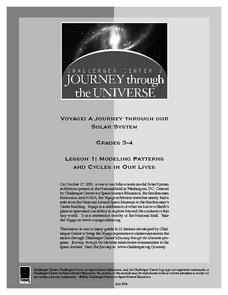Curated OER
Digging in the Classroom
First graders "excavate" a story. In this creative earth science lesson, 1st graders become archaeologists and dig through a box of dirt or other material to find pictures from a picture book. It is their job to then put them in order.
Curated OER
Base 3
Students investigate this problem that aims to give a better idea of our decimal system by looking at a comparable system - the base 3 system. By seeing how base 3 numbers work students should have a better appreciation of base 10...
Curated OER
Estimation Using Goldfish Crackers: Math
Second graders explore estimation and rounding concepts using goldfish crackers and a song! They solve problems by estimating and rounding numbers and pick numbers within reason to represent certain objects.
Curated OER
Can Stack
Students are able to find the rule for summing consecutive numbers;
identify the pattern of triangular numbers. They then solve the given problem using logic and mathematical reasoning.
Curated OER
Max's Math Adventures
In this math riddle worksheet, students read through the rhyming math poem about the 'Card Castle Addition.' Students list all the ways they can come up with 14 using two numbers. Students then solve the final number sentence problems...
Curated OER
Fractions
First graders are asked to put their fingers on their triangles that looks like the one that is on the overhead. They are asked to tell how they would write a fraction for this one part. Students go through step one until all of the...
Curated OER
H2O in Us
Students discover through this activity that all organisms are composed of water. They find that 70 percent of their bodies are made up of water that is in thier cells and blood, and not free-flowing throughout their body.
Curated OER
Mahler: Ruckert Lieder: ‘Urn Mitternacht’ [1905]
In this music learning exercise, student analyze an extract of the given piece of music by answering a series of 11 questions about the music in general. They then answer 16 questions about the structure of the two specified sections of...
Curated OER
Fact Families in Kid Pix
Second graders study Fact Families in Kid Pix. They use the mouse to open, close and navigate within this application. They assess one click to select, double click to open, drag to highlight, drag and drop, drag to select an area, use...
Curated OER
Allowance Time
Students complete a worksheet in which they determine ways of using coins to make the value of $1.00.
Curated OER
Patterns, Relations And Functions
Fourth graders observe patterns and determine a mathematical function that creates the pattern. Through a demonstration by the teacher, they observe strategies such as multiplication, division, addition, and subtraction to use when...
Curated OER
The Media and Social Justice in Your Community
Young scholars study symbolism in media. They listen to two Hip Hop songs and watch the videos for them. They identify symbols and their meanings based on the context of the images seen in the videos and the lyrics heard.
Curated OER
The Birds and the Bees, and the Flowers and the Trees
Learners examine the roles in which animals play in the pollination of plants. They recognize that flowers have male and female sexes. Students describe cross pollination and propose reasons for cross pollination through narration of a...
Curated OER
Mountain Building
Fourth graders identify variables that influence rates of change. They, through group consensus and using the assigned materials, design and build what they believe to be the strongest mountain possible.
Curated OER
Ending Apartheid
Students analyze how the roles are changing for women in South Africa. Using the internet, they research famous women from around the world who helped advance a women's place in society. They create a storybook about their famous...
Curated OER
Unit Perimeters and Areas
Students use Geometers SketchPad to find the area and perimeter of several shapes. In this geometry lesson, students determine area of rectangles and progress through irregular polygons. None of the referenced worksheets are included...
Curated OER
Bless Me, Ultima: Dialogue Journals
Tenth graders read Chapter 1 of the novel "Bless Me, Ultima" and respond to the text. They answer and ask questions and record their impressions of different aspects of the book in a dialogue journal format with a partner. Students...
Curated OER
Effect of Acid Rain on Plants
Students observe the effects of acid rain on plants through experimentation and research. Students research types of crops in their area. Students work in small groups to complete the experiments given, as well as write a report and...
Curated OER
Olympic Games - Can You Measure Up?
Students complete 6 units to learn about Ancient Greece and the Olympic games through physical education activities as well as math activities. In this Ancient Greece lesson, students complete multiple activities in 6 lessons including...
Curated OER
Time, Tide, and Quahogs
Students read tide tables for Waquoit Bay as the simulate determining the best time to go clam digging for a Wampanoag clambake. They graph the tide tables while realizing that the tides a Waquoit Bay are one hour later than those at...
Curated OER
Geography: I Spy Environments
Fourth graders examine nature paintings from a Utah museum for their physical characteristics. In small groups, they observe museum postcards and discuss the season, precipitation, temperature, and geometric shapes pictured. Focusing...
Curated OER
Spotlight on Students
First graders participate in social skills activities at the beginning of they school year that including graphing work. Each student acts as the "Top Banana" while other students ask them questions about their likes and dislikes. As a...
Curated OER
Addition and Subtraction Facts to 20
Fact families, and the relationship between addition and subtraction are the foucs of this lesson plan. Learners explore strategies to help with their addition and subtraction facts. They use doubles, related facts, and fact families to...
Curated OER
Modeling Patterns and Cycles in Our Lives
Students explore how building a model can help them better understand the natural world. They identify common cycles or patterns in nature as well as examples of models in the classroom. After discussion, they choose a pattern or cycle...







![Mahler: Ruckert Lieder: ‘Urn Mitternacht’ [1905] Worksheet Mahler: Ruckert Lieder: ‘Urn Mitternacht’ [1905] Worksheet](http://content.lessonplanet.com/resources/thumbnails/166589/large/cgrmlwnvbnzlcnqymdezmdmzmc01nda4lwu3zgttzi5qcgc.jpg?1414266897)
